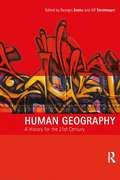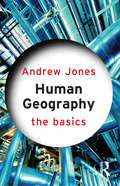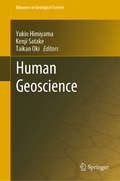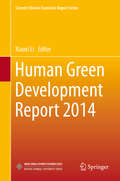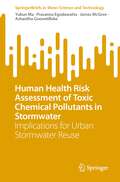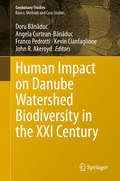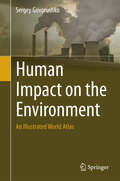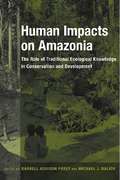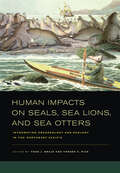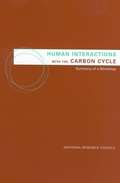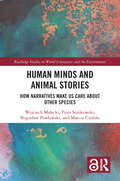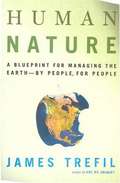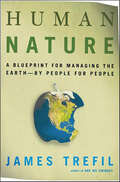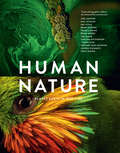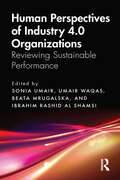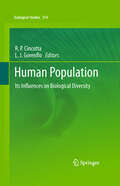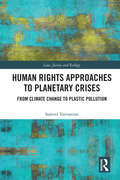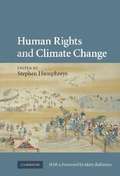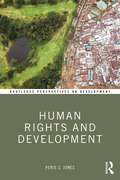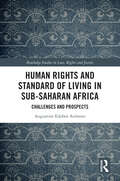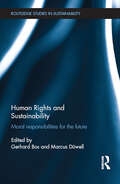- Table View
- List View
Human Geography of the UK: An Introduction
by Eleonore Kofman Irene Hardill David GrahamThis new key textbook for introductory courses in human geography provides first and second-year undergraduates with a comprehensive thematic approach to the changing human geography of the UK at the end of the twentieth and beginning of the twenty-first century. Covering local, regional, national, European and global issues, it also explores in some detail topics which are part of the lived experience of undergraduates themselves, such as crime, unemployment, social exclusion and AIDS.User-friendly textbook features include:* chapter introductions, summaries and important theoretical principles* up-to-date further reading and key on-line sources* case studies, examples and revision questions.
Human Geography: A History for the Twenty-First Century (Human Geography in the Making)
by Ulf Strohmayer Georges Benko'Human Geography' examines the major trends, debates, research and conceptual evolution of human geography during the twentieth century. Considering each of the subject's primary subfields in turn, it addresses developments in both continental European and Anglo-American geography, providing a cutting-edge evaluation of each.Written clearly and accessibly by leading researchers, the book combines historical astuteness with personal insights and draws on a range of theoretical positions. A central theme of the book is the relative decline of the traditional subdisciplines towards the end of the twentieth century, and the continuing movement towards interdisciplinarity in which the various strands of human geography are seen as inextricably linked.This stimulating and exciting new book provides a unique insight into the study of geography during the twentieth century, and is essential reading for anyone studying the history and philosophy of the subject.
Human Geography: The Basics (The Basics)
by Andrew JonesHuman Geography: The Basics is a concise introduction to the study of the role that humankind plays in shaping the world around us. Whether it’s environmental concerns, the cities we live in or the globalization of the economy, these are issues which affect us all. This book introduces these topics and more including: global environment issues and development cities, firms and regions migration, immigration and asylum landscape, culture and identity travel, mobility and tourism agriculture and food. Featuring an overview of theory, end of chapter summaries, case study boxes, further reading lists and a glossary, this book is the ideal introduction for anybody new to the study of human geography.
Human Geoscience (Advances in Geological Science)
by Taikan Oki Yukio Himiyama Kenji SatakeThis book is a product of the joint efforts of interdisciplinary academic fields under the integrative framework of human geoscience. Human geoscience is a new genre of geoscience concerned with the natural phenomena that occur on the surface of the Earth and their relations with human activities. It therefore has connections with many fields of geoscience, namely, physical geography, geomorphology, geology, soil science, sedimentology, seismology, volcanology, meteorology, climatology, oceanography, and hydrology. It also has strong links to the humanities, social sciences, agricultural sciences, and engineering related to disaster prevention or mitigation. All these disciplines are important fields for understanding disasters and global environmental problems and for evaluating the associated risks comprehensively, then proposing mitigation strategies.The volume is designed for those who may not necessarily have a geoscience background but have broad scientific interest in understanding the causes, mechanisms, and consequences of geo-disasters and global environmental problems and wish to make the world more sustainable on that basis. The book consists of six parts: I. Introduction, II. Earth Surface Realms, III. Natural Resources and Society, IV. Natural Hazards and Society, V. Global Environmental Problems, and VI. Global Sustainability Programmes and Human Geoscience, which discusses the contribution of this field of science to a new comprehensive framework for global sustainability.
Human Green Development Report 2014
by Xiaoxi LiThis exhaustive survey assesses the performance of the United Nations and its member states in all key areas, at the same time as laying down a road map for sustainable development in the future. Deploying the Human Green Development Index as a new metric for an era in which human survival is intimately dependent on the viability of the Earth as a clean and sustainable habitat, the report showcases a vast array of data, including HGDI indicators for more than 120 nations. It provides a detailed and comparative rationale for the selection of data for the 12 goals and 54 HGDI targets, which cover human and global needs into the future. The index measures 12 Sustainable Development Goals, based on but also extending the eight Millennium Development Goals defined in 2000. The SDGs, proposed by a high-level UN panel, will supersede MDGs in 2015. They focus on ending poverty, achieving gender equality, providing quality education for all, helping people live healthy lives, securing sustainable energy use, and creating jobs offering sustainable livelihoods. They also work towards equitable growth, stable and peaceful societies, greater efficiency in governance, and closer international cooperation. With indicators covering everything from air particulates to percentage of threatened animal species in a nation's total, and informed by the latest research (with inequality-adjusted metrics for amenities such as education and healthcare), this comprehensive study offers readers not only a wealth of valuable core data, but also a well-argued rationale for using the HGDI. In today's world, we cannot view our development as being distinct from, and unaffected by, that of the Earth we inhabit, or that of our planetary cohabitees.
Human Health Risk Assessment of Toxic Chemical Pollutants in Stormwater: Implications for Urban Stormwater Reuse (SpringerBriefs in Water Science and Technology)
by Ashantha Goonetilleke Prasanna Egodawatta James McGree Yukun MaThis book presents a detailed analysis in relation to human health risk assessment of the main toxic chemical pollutants in urban stormwater generated from urban traffic and land use activities. The knowledge presented in this book was derived based on comprehensive experimental investigations including field sampling, laboratory testing, mathematical modelling, spatial analysis and multivariate and univariate statistical data analyses. The key highlights of the book include the quantitative assessment of the human health risk posed by key toxic chemical pollutants in urban stormwater and the development of linkages between risk and traffic and land use. Additionally, a suite of mathematical equations are presented to predict human health risk based on traffic and land use characteristics through mathematical modelling. These outcomes can significantly assist in effective stormwater risk management under changing traffic and land use in the urban environment. The knowledge presented is of particular interest to readers such as stormwater treatment design specialists, decision-makers and urban planners since these outcomes provide practical suggestions and recommendations for effective urban stormwater treatment design.
Human Impact on Danube Watershed Biodiversity in the XXI Century (Geobotany Studies)
by Franco Pedrotti Doru Bănăduc Angela Curtean-Bănăduc Kevin Cianfaglione John R. AkeroydThe second-longest European river after the Volga, the Danube is one of the world’s most important rivers in terms of its geographical and historical significance. In recent history, it has served as a major international waterway and numerous cities, including four capitals, have been founded on its banks. The 2826km-long Danube has a watershed measuring 801,093 km2 that is now shared between 19 countries, from its source in the Black Forest to the Black Sea, into which it pumps an average of 827 km3 of water a year. This book describes and explains key landscape values interactions (geographical, cultural and natural heritage). It also identifies the threats and various types of human impact affecting this system in all the countries of the Danube River Basin, based on the investigations and perspectives of a team of experienced naturalists, and in the context of the early 21st century, in which the human-nature relationship is still far from balanced. These studies demonstrate how biodiversity, conservation and ecological studies can help us successfully promote mutual cooperation and combine our efforts to address problems as a responsible continent.
Human Impact on the Environment
by Sergey GovorushkoThis atlas presents a collection of geographical maps showing human impact on the environment. A wide variety of human impacts are discussed, ranging from the energy, mining, transport and agricultural industries as well as less visible impacts such as those of space exploration. This book is a highly illustrated atlas with 300 photos from 70 countries. Each map is accompanied by a short description of each human impact and its effect on the specific natural environment.
Human Impacts on Amazonia: The Role of Traditional Ecological Knowledge in Conservation and Development (Biology and Resource Management Series)
by Michael Balick Darrell PoseyFrom the pre-Columbian era to the present, native Amazonians have shaped the land around them, emphasizing utilization, conservation, and sustainability. These priorities stand in stark contrast to colonial and contemporary exploitation of Amazonia by outside interests. With essays from environmental scientists, botanists, and anthropologists, this volume explores the various effects of human development on Amazonia. The contributors argue that by protecting and drawing on local knowledge and values, further environmental ruin can be avoided.
Human Impacts on Seals, Sea Lions, and Sea Otters: Integrating Archaeology and Ecology in the Northeast Pacific
by Torben C. Rick Todd J. BrajeFor more than ten thousand years, Native Americans from Alaska to southern California relied on aquatic animals such as seals, sea lions, and sea otters for food and raw materials. Archaeological research on the interactions between people and these marine mammals has made great advances recently and provides a unique lens for understanding the human and ecological past. Archaeological research is also emerging as a crucial source of information on contemporary environmental issues as we improve our understanding of the ancient abundance, ecology, and natural history of these species. This groundbreaking interdisciplinary volume brings together archaeologists, biologists, and other scientists to consider how archaeology can inform the conservation and management of pinnipeds and other marine mammals along the Pacific Coast.
Human Interactions with the Carbon Cycle: Summary of a Workshop
by Paul C. SternThe results of a November 2001 workshop on human interactions with the carbon cycle are summarized here, focusing on the future of fossil fuel consumption, carbon implications of future land use/land cover transformation, and modeling human interactions with the carbon cycle. There is no subject index. Annotation (c)2003 Book News, Inc. , Portland, OR (booknews. com)
Human Minds and Animal Stories: How Narratives Make Us Care About Other Species (Routledge Studies in World Literatures and the Environment)
by Wojciech Małecki Piotr Sorokowski Bogusław Pawłowski Marcin CieńskiThe power of stories to raise our concern for animals has been postulated throughout history by countless scholars, activists, and writers, including such greats as Thomas Hardy and Leo Tolstoy. This is the first book to investigate that power and explain the psychological and cultural mechanisms behind it. It does so by presenting the results of an experimental project that involved thousands of participants, texts representing various genres and national literatures, and the cooperation of an internationally-acclaimed bestselling author. Combining psychological research with insights from animal studies, ecocriticism and other fields in the environmental humanities, the book not only provides evidence that animal stories can make us care for other species, but also shows that their effects are more complex and fascinating than we have ever thought. In this way, the book makes a groundbreaking contribution to the study of relations between literature and the nonhuman world as well as to the study of how literature changes our minds and society. "As witnessed by novels like Black Beauty and Uncle Tom’s Cabin, a good story can move public opinion on contentious social issues. In Human Minds and Animal Stories a team of specialists in psychology, biology, and literature tells how they discovered the power of narratives to shift our views about the treatment of other species. Beautifully written and based on dozens of experiments with thousands of subjects, this book will appeal to animal advocates, researchers, and general readers looking for a compelling real-life detective story." - Hal Herzog, author of Some We Love, Some We Hate, Some We Eat : Why It’s So Hard To Think Straight About Animals
Human Nature: A Blueprint for Managing the Earth-By People, for People
by James S. TrefilTrefil, a leading scientist, is certainly qualified to tackle the controversial, timely topic of how humans ought to affect the planet they live on. He argues that from the dawn of an agricultural society, man has always engineered nature to suit his needs. And because we're the only form of life with the ability to move mountains (as much literally as metaphorically), there's no rational reason not to manage the environment
Human Nature: A Blueprint for Managing the Earth—by People, for People
by James TrefilA radical approach to the environment which argues that by harnessing the power of science for human benefit, we can have a healthier planetAs a prizewinning theoretical physicist and an outspoken advocate for scientific literacy, James Trefil has long been the public's guide to a better understanding of the world. In this provocative book, Trefil looks squarely at our environmental future and finds-contrary to popular wisdom-reason to celebrate. For too long, Trefil argues, humans have treated nature as something separate from themselves-pristine wilderness to be saved or material resources to be exploited. What we need instead is a scientific approach to the environment that embraces the human transformation of nature for our benefit. In Human Nature, Trefil exposes the benefits of genetically modified species, uncovers vital facts about droughts and global warming, and points to examples of environmental management where catering to humans reaps greater rewards than sheltering other species. By taking advantage of explosive advances in the sciences, we can fruitfully manage the planet, if we rise to the challenge. Like Rachel Carson's Silent Spring and Paul Ehrlich's Population Bomb, Human Nature promises to fundamentally alter the way we perceive our relationship to the Earth-but with optimism rather than alarm.
Human Nature: Nine Ways to Feel About Our Changing Planet
by Kate MarvelA captivating exploration of climate change that uses nine different emotions to better understand the science, history, and future of our evolving planetScientist Kate Marvel has seen the world end before, sometimes several times a day. In the computer models she uses to study climate change, it’s easy to simulate rising temperatures, catastrophic outcomes, and bleak futures. But climate change isn’t just happening in those models. It’s happening here, to the only good planet in the universe. It’s happening to us. And she has feelings about that. Human Nature is a deeply felt inquiry into our rapidly changing Earth. In each chapter, Marvel uses a different emotion to explore the science and stories behind climate change. As expected, there is anger, fear, and grief—but also wonder, hope, and love. With her singular voice, Marvel takes us on a soaring journey, one filled with mythology, physics, witchcraft, bad movies, volcanoes, Roman emperors, sequoia groves, and the many small miracles of nature we usually take for granted.Hopeful, heartbreaking, and surprisingly funny, Human Nature is a vital, wondrous exploration of how it feels to live in a changing world.Human Nature is a biography of the Earth in nine emotions:WonderAngerGuiltFearGriefSurprisePrideHopeLove
Human Nature: Planet Earth In Our Time: Twelve Photographers Address the Future of the Environment
by Geoff Blackwell Ruth HobdayIn Human Nature, 12 of today's most influential nature and conservation photographers address the biggest environmental concerns of our time.• Joel Sartore• Paul Nicklen• Ami Vitale• Brent Stirton• Frans Lanting• Brian Skerry• Tim Laman• Cristina Mittermeier• J Henry Fair• Richard John Seymour• George Steinmetz• Steve WinterAlongside their reflections, they present curated selections from their photographic careers. Stories and extraordinary images from around the world come together in a powerful call to awareness and action.• The United Nations has declared that nature is in more trouble now than at any other time in human history.• Extinction looms over one million species of plants and animals.• Human Nature wrestles with challenging questions: What do we have? What do we stand to lose?This book offers inspiration to environmentalists, activists, photography fans, and anyone concerned about the future of our world.• This illuminating book tackles our modern environmental future through the lens of preeminent photographers• Great gift for photographers, nature enthusiasts, those who enjoy backpacking and camping, and anyone who cares about Earth's climate and future• Add it to the shelf with books like National Geographic The Photo Ark Vanishing: The World's Most Vulnerable Animals by Joel Sartore, The Sixth Extinction: An Unnatural History by Elizabeth Kolbert, and Dire Predictions: The Visual Guide to the Findings of the IPCC by Michael E. Mann and Lee R. Kump.
Human Perspectives of Industry 4.0 Organizations: Reviewing Sustainable Performance
by Beata Mrugalska Sonia Umair Umair Waqas Ibrahim Rashid Al ShamsiSustainability is a global issue and, with the advent of further legislation to make organizations "greener," companies are keen to promote sustainable performance to survive in the market. Using the facets of Industry 4.0, companies can become leaner and cleaner and measure their performance more effectively. This book reveals the sustainable innovations that organizations are undertaking because of Industry 4.0.This book focuses on sophisticated aspects of how to make products tailor-made to suit specific requirements. It seeks to understand the status of sustainable performance that is impacted by different aspects related to human factors and concludes with detailing the future needs of businesses and potential trends. The book allows the reader to develop a deeper view of sustainability and organizational problems and to bridge the gap between theory and practice. Each chapter contains a self-contained study of a business and the decisions made to improve performance and is supported with tables, charts, and illustrations, and a wide list of bibliographic references.Human Perspectives of Industry 4.0 Organizations will be of interest to students, graduates, researchers, and practitioners in the fields of logistics, supply chain management, management, leadership, organization, and sustainability, plus those interested in Industry 4.0 more generally. It will appeal to students in graduate programs covering sustainable aspects of business, management, supply chain management, and industrial engineering.
Human Population
by Richard P. Cincotta Larry J. GorenfloIn this volume the dynamic patterns of human density and distribution are examined in relation to the viability of native species and the integrity of their habitats. Social, biological, and earth scientists describe their models, outline their conclusions from field studies, and review the contributions of other scientists whose work is essential to this field. The book starts with general theories and broad empirical relationships that help explain dramatic changes in the patterns of the occurrence of species, changes that have developed in parallel with human population growth, migration and settlement. In the following chapters specific biomes and ecosystems are highlighted as the context for human interactions with other species. A discussion of the key themes and findings covered rounds out the volume. All in all, the work presents our species, Homo sapiens, as what we truly have been and will likely remain--an influential, and often the most influential, constituent in nearly every major ecosystem on Earth.
Human Resources in the Urban Economy (Routledge Revivals)
by Mark PerlmanDue to the urbanisation of American society and the economic problems that accompanied it; a series of conferences was held to explore the economics of human resources. Originally published in 1963, this study draws together papers from the first conference dealing mainly with the under-utilisation and misallocation of human resources, as well as wage rates, migration patterns and education in urban societies and the impact they have on the American labour force. This title will be of interest to students of Environmental Studies and Economics.
Human Rights Approaches to Planetary Crises: From Climate Change to Plastic Pollution (ISSN)
by Samvel VarvastianThis book analyses over 20 years of rights-based litigation in the areas of climate change and plastic pollution in order to assess the value of rights in confronting and overcoming planetary crises.We live in an age of planetary crises such as climate change, biodiversity loss, and plastic pollution, which take a huge toll on communities all around the world, endangering their fundamental interests. But can the lack of government action on these crises – or action that worsens them – amount to violations of human rights? Many courts are grappling with this question, as rights-based litigation becomes increasingly common. By focusing on climate change and plastic pollution as case studies, this book examines the viability of rights claims when confronting planetary crises in courts. From early attempts to pursue rights claims in response to planetary crises in the first decade of the 2000s to high-profile court wins in such cases in the 2010s and the spread of such cases across dozens of jurisdictions by the 2020s, rights claims in climate change and plastic pollution litigation have become a truly global phenomenon. Through a systematic and in-depth analysis of such litigation in more than thirty jurisdictions, this book identifies factors that determine the viability of rights claims when confronting planetary crises. It reveals that, even though not all litigation forums are equally favourable to such claims, human rights can indeed be successfully invoked in different types of legal action.This book will be of considerable interest to policymakers and legal scholars and practitioners, as well as students, who work in or study environmental and climate change law, human rights law, constitutional law, and international and comparative law.
Human Rights and Climate Change
by Stephen Humphreys Mary RobinsonAs the effects of climate change continue to be felt, appreciation of its future transformational impact on numerous areas of public law and policy is set to grow. Among these, human rights concerns are particularly acute. They include forced mass migration, increased disease incidence and strain on healthcare systems, threatened food and water security, the disappearance and degradation of shelter, land, livelihoods and cultures, and the threat of conflict. This inquiry into the human rights dimensions of climate change looks beyond potential impacts to examine the questions raised by climate change policies: accountability for extraterritorial harms; constructing reliable enforcement mechanisms; assessing redistributional outcomes; and allocating burdens, benefits, rights and duties among perpetrators and victims, both public and private. The book examines a range of so-far unexplored theoretical and practical concerns that international law and other scholars and policy-framers will find increasingly difficult to ignore.
Human Rights and Development (Routledge Perspectives on Development)
by Peris S JonesThe emergence of human rights within development and the evolving relationship was increasingly brought to bear upon key debates and policies over the last couple of decades. This book provides a critically informed, comprehensive and multi-disciplinary entry-level account of this engagement between human rights and development. It is theoretically and practically grounded and explores three over-arching questions and themes: First, why and how have human rights made this breakthrough? Second, is there agreement on human rights as a concept and how it is being used and understood within diverse development practices at global, national and local levels? Third, how can we gauge the impact of human rights based approaches upon development outcomes? The book concludes with what the future may hold for human rights and development. In-depth understanding of human rights as a development challenge and development as a human rights one, is presented and delineates the diverse responses and alternative critical approaches. Wide ranging in scope, it covers many examples of human rights within development, including global policy initiatives, and vulnerable groups, such as those living in poverty, socially excluded, people living with HIV/AIDS, residents of informal settlements, and human rights defenders. This textbook will be an essential resource for social science students, particularly in the fields of development studies, human rights and geography, as well as those interested in the intersection between law, human rights and social change. It should also appeal to practitioners in development and human rights.
Human Rights and Standard of Living in Sub-Saharan Africa: Challenges and Prospects (Routledge Studies in Law, Rights and Justice)
by Augustine Edobor ArimoroThis book offers a comprehensive and nuanced examination of the right to an adequate standard of living in Sub-Saharan Africa (SSA), shedding light on the multifaceted challenges, opportunities, and imperatives for action. The right to an adequate standard of living is a fundamental human right, essential for the dignity and well-being of all individuals. Yet, in SSA, the realisation of this right remains a complex and elusive goal, with millions of people facing poverty, inequality, and limited access to basic services. Through a series of in-depth chapters, the book explores the various dimensions of the right to an adequate standard of living, from the pervasive impacts of poverty and inequality to the critical importance of access to healthcare, education, housing, and justice. Drawing on a rich array of case studies, data, and expert analysis, the work provides a compelling and evidence-based assessment of the current state of affairs in SSA, highlighting the urgent need for comprehensive and context-specific approaches to advancing this fundamental right. Providing a roadmap for promoting sustainable and inclusive development, reducing poverty and inequality, and ensuring access to basic services for all, the volume offers a set of actionable recommendations for policymakers, practitioners, and researchers working in the areas of Human Rights Law, Development Law and, in particular, those focused on the United Nations Sustainable Development Goals. At the same time, it identifies key areas for further research and investigation, underscoring the importance of ongoing knowledge generation and exchange in support of evidence-based policy and practice.
Human Rights and Sustainability: Moral responsibilities for the future (Routledge Studies in Sustainability)
by Gerhard Bos and Marcus DüwellThe history of human rights suggests that individuals should be empowered in their natural, political, political, social and economic vulnerabilities. States within the international arena hold each other responsible for doing just that and support or interfere where necessary. States are to protect these essential human vulnerabilities, even when this is not a matter of self-interest. This function of human rights is recognized in contexts of intervention, genocide, humanitarian aid and development. This book develops the idea of environmental obligations as long-term responsibilities in the context of human rights. It proposes that human rights require recognition that, in the face of unsustainable conduct, future human persons are exposed and vulnerable. It explores the obstacles for long-term responsibilities that human rights law provides at the level of international and national law and challenges the question of whether lifestyle restrictions are enforceable in view of liberties and levels of wellbeing typically seen as protected by human rights. The book will be of interest to postgraduates studying Human Rights, Sustainability, Law and Philosophy.
Human Rights and the Environment: Conflicts and Norms in a Globalizing World
by Lyuba ZarskyThe impact of environmental damage on human rights - civil, political or welfare and labour rights - is becoming ever-more widely appreciated and has direct bearing on the behaviour of companies and their norms of conduct. In this volume, contributors draw on the tools and insights of a range of disciplines, including law, anthropology, economics, geography and social science, to analyze the issues and show how new standards that protect rights and liberties can be established.

